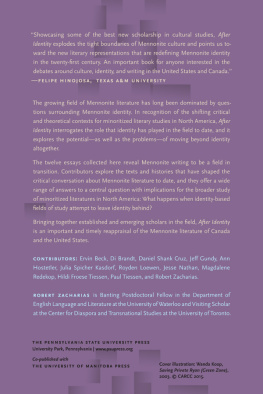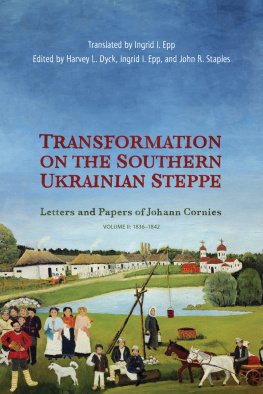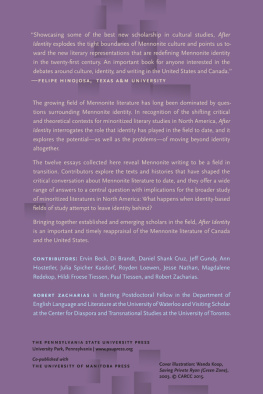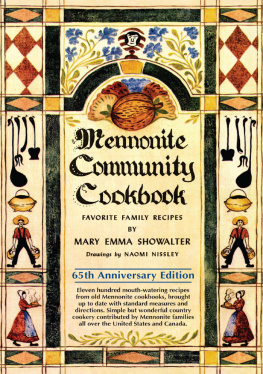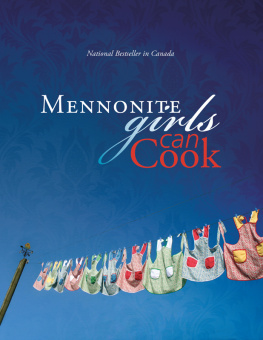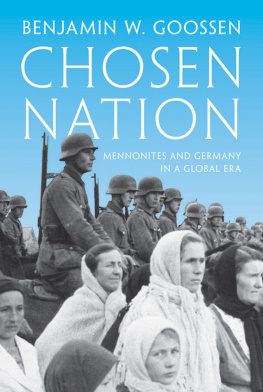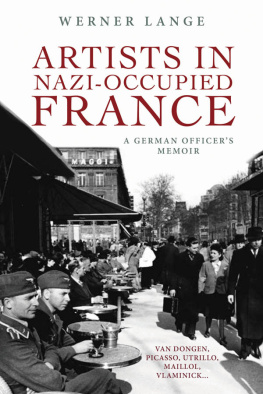The Constructed Mennonite
History, Memory, and the Second World War
Hans Werner
University of Manitoba Press
Winnipeg, Manitoba
Canada R3T 2M5
uofmpress.ca
Hans Werner 2013
Printed in Canada
Text printed on chlorine-free, 100% post-consumer recycled paper
16 15 14 13 1 2 3 4 5
All rights reserved. No part of this publication may be reproduced or transmitted in any form or by any means, or stored in a database and retrieval system in Canada, without the prior written permission of the University of Manitoba Press, or, in the case of photocopying or any other reprographic copying, a licence from Access Copyright (Canadian Copyright Licensing Agency). For an Access Copyright licence, visit www.accesscopyright.ca, or call 1-800-893-5777.
Cover design: Frank Reimer
Interior design: Karen Armstrong Graphic Design
Maps: Weldon Hiebert
All photos courtesy the author.
Library and Archives Canada Cataloguing in Publication
Werner, Hans, 1952
The constructed Mennonite : history, memory, and the Second World War / Hans Werner.
Includes bibliographical references and index.
Issued also in electronic formats.
ISBN 978-0-88755-741-5 (pbk.)
ISBN 978-0-88755-436-0 (PDF e-book)
ISBN 978-0-88755-438-4 (epub e-book)
1. Werner, John, 19172003. 2. MennonitesRussia (Federation) SiberiaBiography. 3. MennonitesManitobaBiography. 4. Immigrants ManitobaBiography. 5. StorytellersManitobaBiography. 6. Ex-prisoners of warManitobaBiography. 7. World War, 19391945Biography. 8. World War, 1939-1945Influence. 9. Autobiographical memory. I. Title.
BX8143.W37W37 2013 289.7092 C2012-908123-X
The University of Manitoba Press gratefully acknowledges the financial support for its publication program provided by the Government of Canada through the Canada Book Fund, the Canada Council for the Arts, the Manitoba Department of Culture, Heritage, Tourism, the Manitoba Arts Council, and the Manitoba Book Publishing Tax Credit.
Contents
To Kadin, Abigail, Anna and David
Acknowledgements
I want to thank Royden Loewen, Dan Stone, Melissa Werner, Jim Suderman and the anonymous readers for U of M Press for taking the time to read and offer thoughtful comments on earlier versions of this book. I am also indebted to archivists at the Mennonite Heritage Centre in Winnipeg, the Mennonite Church Archives at Goshen College, Goshen, Indiana, and the German Military Archives in Freiburg, Germany, for their assistance in helping me to uncover and make available what were often obscure sources. It was a pleasure working with Weldon Hiebert on the maps and I again benefitted from the patience and interest of David Carr and his staff at U of M Press. I am most indebted to my parents, John and Margaret Werner, both of whom have passed on, for patiently telling their stories over and over again. In spite of this much appreciated assistance, the responsibility for what is in these pages is solely mine.
Introduction
It was one of those March days in the southern Canadian prairies when the suns warmth has the feel of spring but the air still has an edge of winter. I travelled alone from Winnipeg to Steinbach, Manitoba, a small city forty-five minutes away where I had grown up, to visit my father in the hospital. He had been diagnosed with stomach cancer some months earlier and had steadily been losing weight because he could no longer eat properly. When the surgeon performed exploratory surgery, it was I who had to tell my father there was nothing that could be done for his illness, and though it was not a subject he discussed, he knew he was dying. On this Sunday, I knew I would be alone with him, and the thought crossed my mind that the circumstances of my visit might free him to tell stories he had never told before.
My father told stories about his life experiences for as long as I can remember, and together with my mothers autobiography his stories of the Stalinist years in the Soviet Union, the experiences of the Second World War, and the immigrant experience in Canada framed who we were and are. The stories were fantastic tales for a boy growing up in a sleepy Mennonite town in southern Manitoba. My need to understand my fathers stories became more acute when I became an adult, and in the 1980s, some twenty years before the March trip, I interviewed my parents more formally and tried to uncover any additional sources that could shed light on their remarkable life story.
The primary subject of this book is my fathers story and how it was told, and the book has two purposesthe first is to tell the life story of an otherwise ordinary person who experienced the upheavals of the twentieth century in the form of war and totalitarianism from a unique perspective. As David Thelen says in an essay on the relationship between individual experience and history, this account of my fathers life is an attempt to join the process of creating history with the experience of living life.
My father was born to Johann and Anna (Janzen) Werner in 1917, just after the Bolshevik Revolution. He was named Hans, and in the German-speaking community where he grew up he kept that name until he went to school. Then in Stalinist Russia he became Ivan and part of Stalins hope to transform the Soviet Union into a strong, industrialized bastion of communism. When war enveloped the world, he fought as a Red Army soldier, first in the Winter War with Finland, then as a junior officer stationed on the GermanSoviet frontier when the Nazi armies attacked the Soviet Union in June 1941. A new era would begin for him when he was captured by the Germans, only to be resettled in occupied Poland, where he became Johann, was naturalized, and then drafted into Hitlers German army. He fought on the Western Front for the rest of the war before being captured by the Americans in April 1945, a month before the war ended. He was a U.S. prisoner of war until 1946, when he was released and began trying to emigrate to Canada. Before that happened, he married my mother, a refugee with many of the same experiences, and after they finally arrived in Canada in 1952 his life in a new country would be marked by another name change. He became John and lived the life of an ordinary postwar immigrant finding his way in Canada.
The series of namesHans, Ivan, Johann, and Johnwhile referring to the same person mark the various ethnic and national identities that my father negotiated. Each name change in my retelling of his story marks a change in who he was. To his children, however, he was always Papa. His main credits were that he was a skilled auto mechanic, a good husband and provider, the father of a suburban postwar baby boom family. He was always an immigrant in the sense that he never spoke English fluently and was somewhat of an outsider because of his distinctly military past in a town with a sense of itself as a pacifist religious community.
In her reference to Art Spiegelmans Maus, the graphic biography of Spiegelmans father, a Holocaust survivor, Susan Engel suggests that the story is told twice, once to his son and then again to us, his sons readers. It is also heard by two audiences, the son who is finding out what his father endured and why his father is the way he is, and the rest of us, hearing the grim details that augment and bleakly enliven what we know about a distant time and place. The stories told here have a similar pattern. My fathers stories were told first to private audiences, and with this writing they become public and history. From his memories and stories, we gain another perspective on what Stalinism, Nazism, famine, war, and migration meant. His memories in that sense become part of what the collective memory of these events is and will be.




